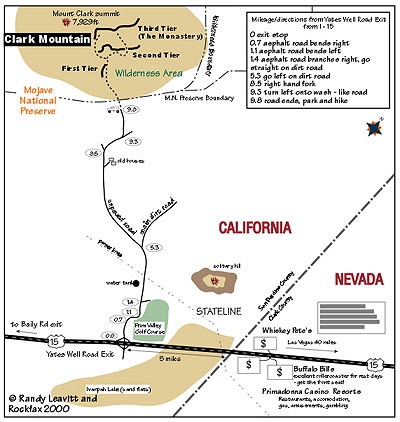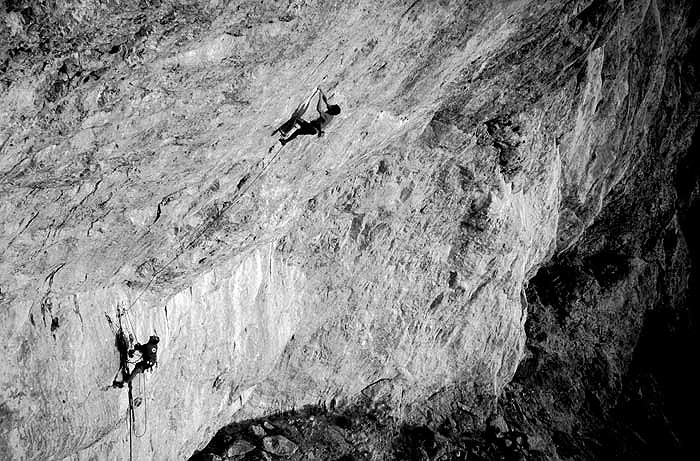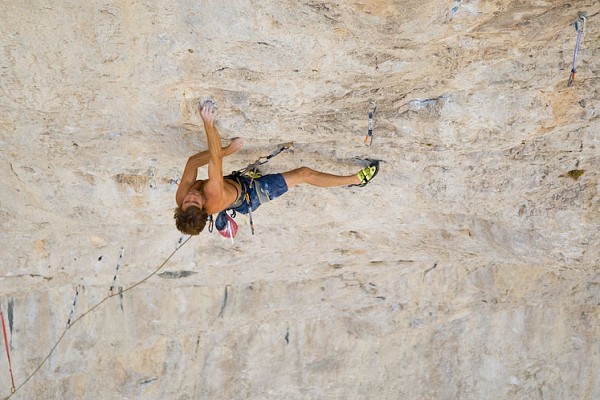INTRODUCTION

High above the desert floor in the Mojave National Preserve, Clark Mountain is sport climbing in an alpine environment. The routes are long and exposed. The place is remote. It has a wild feel. This, along with the exceptionally fine climbing, makes Clark a special place. This is a great crag for those who love to get pumped amongst the mountains and desert.
The rock quality is exceptional. Features are not limited to one type. You'll find it all -- pockets, edges, slopers, pinches, underclings, and cracks. The climbing is always interesting. Each route is distinctive. The climbing doesn't get repetitive or boring. Watch out! Many of the routes are exposed and can be intimidating. And be careful - help is a long way away.
This remote area is beautiful and pristine. Keep it that way. Don't litter. Don't build fires. Keep your impact to a minimum. Don't trample the plants and remember that rare-plant species may be lurking under your big toe. In short, leave no trace. This is not an outdoor gym. This is a Wilderness Area managed by the National Park Service. The use of power drills is prohibited. We want to come back. Make sure that we can. If you want roadside climbing, if you are looking for a spot to bring the baby and the dog, this is not the place. The approaches are steep, trecherous and potentially dangerous. At a minimum, they are technical (some jumaring). This is the domain of competent, experienced climbers.
Watch out for rattlesnakes and scorpions. Though the mountain is far from rattlesnake infested, several big ones have been spotted. Big horn sheep may occasionally visit - give them space. Watch out for big, brown spiders. These arachnids are some of the most intimidating I have ever seen. I don't know what they are, but we call them "Clark Monsters".
BRIEF HISTORY

In 1996, Angelinos Mari Gingery and Mike Lechlinski began establishing some new routes. Their appreciation for the area was apparent as they quickly established some first rate climbs. St. George, Utah, locals Jorge Visser and Todd Perkins frequented the mountain and did several repeats of some of the harder routes. Japan's Hidetaka Suzuki spent a season there and did several repeats. More recently, Francois LeGrand, Jason Campbell, Chris Sharma, Katie Brown, Mia Axon, Chris Lindner and a few other top climbers have been paying visits to test themselves against dramatic lines on the exquisite limestone walls.
WHERE AND HOW
Clark Mountain is in Southeast California near the Nevada border. It is 40 miles south of Las Vegas and 235 miles from downtown Los Angeles. The climbing area is located nine miles off Interstate 15, five miles south of the Nevada border. Geologically, Clark is part of a long chain of limestone outcroppings that stretch through the Great Basin from Nevada and Utah into Wyoming and Montana.
Most of the climbing is on the East Face of Clark Mountain, which forms a series of three tiers. The most well known of these is the upper tier, known as the Monastery. Currently there is also one developed crag on the mountain's South Face, known as the Baily Road Crag.
Off the highway you will need 4 - wheel drive to negotiate the nine miles of dirt road leading to the crag. The road is rough and loose. High clearance is important. Although a low slung sedan will get you part of the way, you will need stamina and big thighs to walk the rest of the way to the crags once the road becomes rough. If the terrain does turn nasty, be prepared to stop and walk. Several cars have had suspensions and engines trashed. Help and tow trucks are a long walk away.
WHEN
The First, Second, and Third Tiers of Clark Mountain are located at elevations of between 6000 feet and 7300+ feet. Therefore the Clark Mountain season usually begins in late April and extends until late November. Climbing here is a summer time pursuit. High elevation and north and eastern exposure combine to make for pleasant climbing while the desert below is hotter than Hades. Most of the routes face either north or east, supplying ample shade for most of the day. The right-end of the Second Tier faces south-east and stays in the sun until late afternoon which is particulary useful in fall and early winter. The area is often snow bound and bitterly cold in the depths of winter.
APPROACH

The crags loom above the parking area. Walk directly toward them, following a trail along a ravine. Stay on the left of the ravine until the trail crosses it to the right. At that point, the trail cuts back left and starts a series of switchbacks as the terrain steepens. You will soon see the First Tier. Don't be deceived; it's not as close as it looks. Continue up until the trail cuts sharply to the left, then eventually makes a sweeping turn right, and traverses over to the First Tier. (30 minutes from the parking lot to the base of the First Tier.)
To attain the Second Tier, continue along the base of the First Tier to the right, around the corner, and up a fourth class gully. At this point the terrain eases up. Continue up the short wash. At the end of the wash follow the slab to the right and continue up to the Second Tier. (Forty-five minutes from the parking lot to the base of the Second Tier.)
There are three approaches to the Third Tier - The Monastery.
To make the direct approach from the First Tier, follow the gully up to the slab, then go up and left until the trail ends at a cliff near a small right-facing corner. Ascending the gully requires 200 feet of fourth and fifth class climbing over loose rock - a fall could send you to hospital (I should know!). This will lead you to level ground above the Second Tier. From this point, climb and scramble up the rock band and steep trail to the Third Tier. (Approximately one hour from the parking lot to the Third Tier, via the direct approach.)
There is a longer but easier way from the Second Tier to the Third Tier. Continue along the base of the Second Tier to the end of the Recluse Wall, follow a gully up and continue over two rocky ridges to the Wall Of Glass at the right end of the Monastery. (About one hour 15 minutes from the parking lot).
A final alternative is to jumar the fixed ropes up the corner at the end of the Warm Up Wall on the Second Tier. Then head left and follow a trail that joins the one used for the direct approach.



Comments